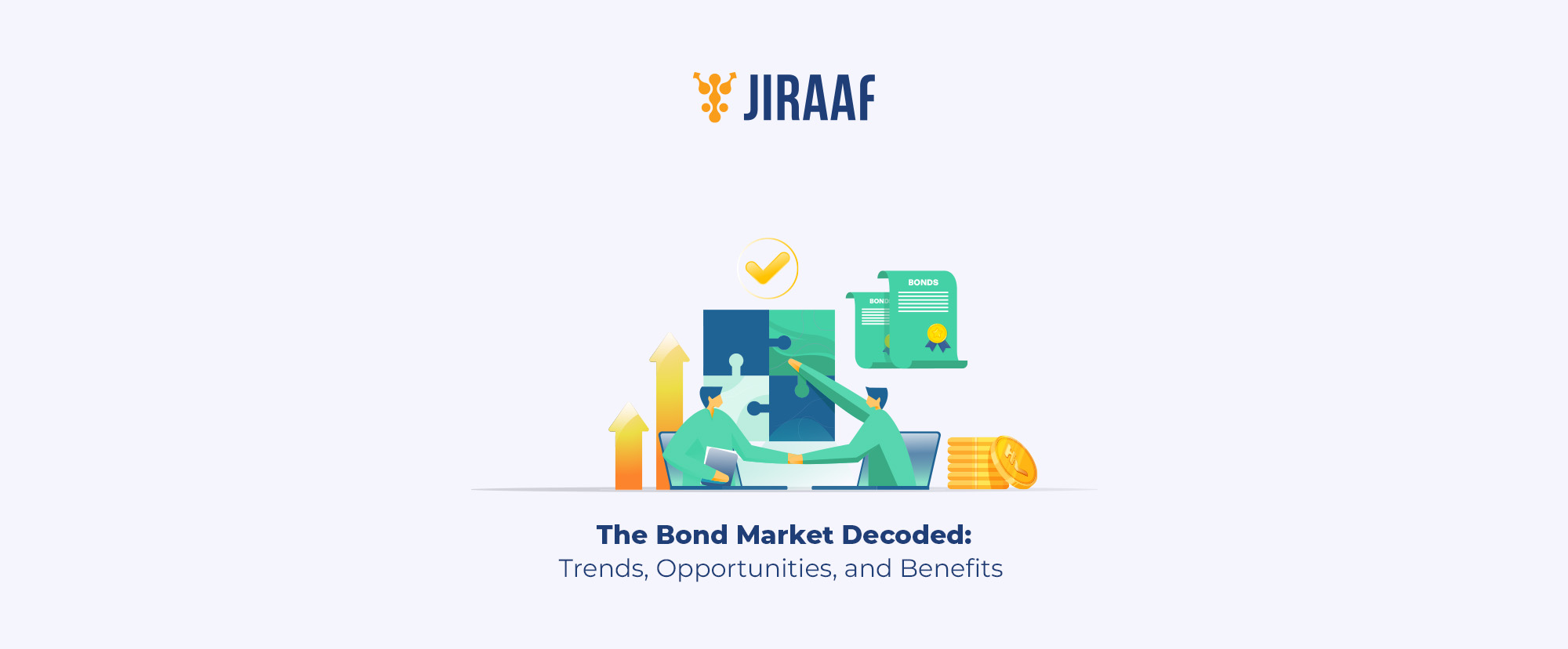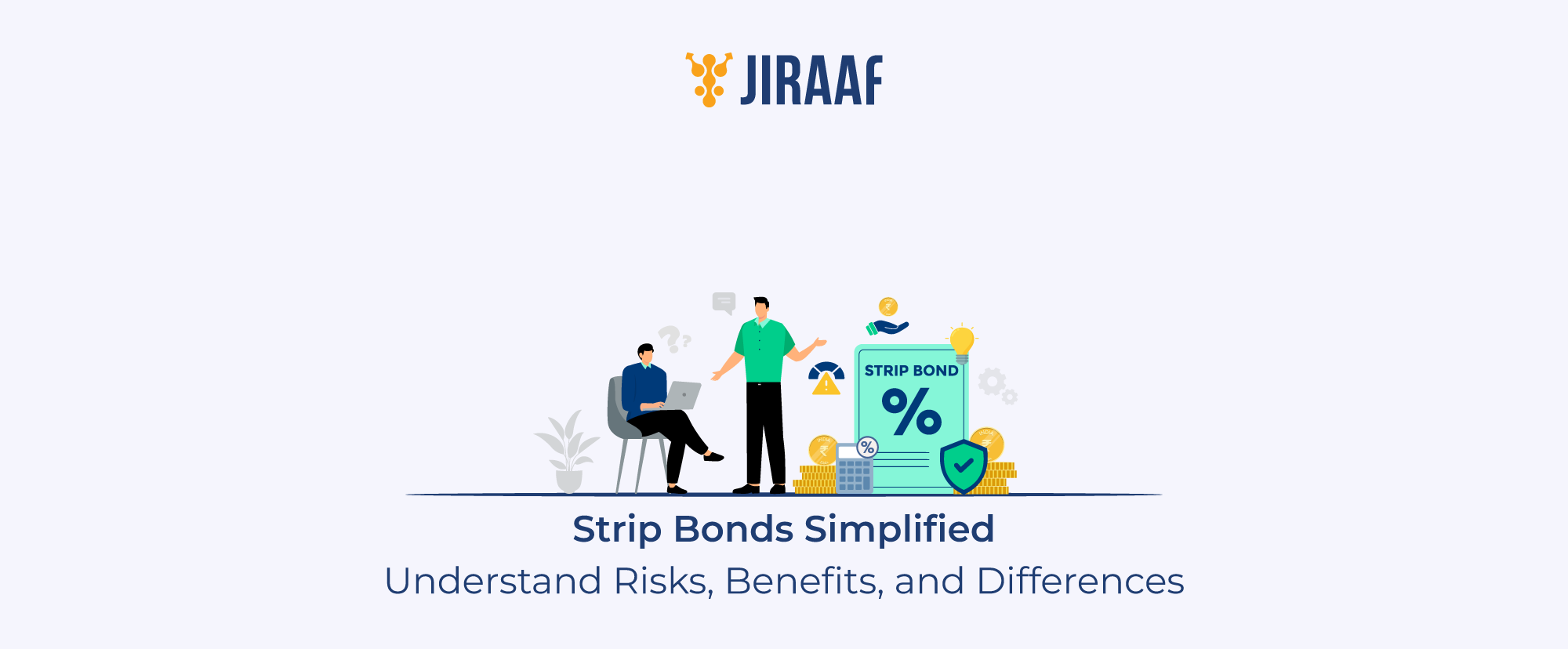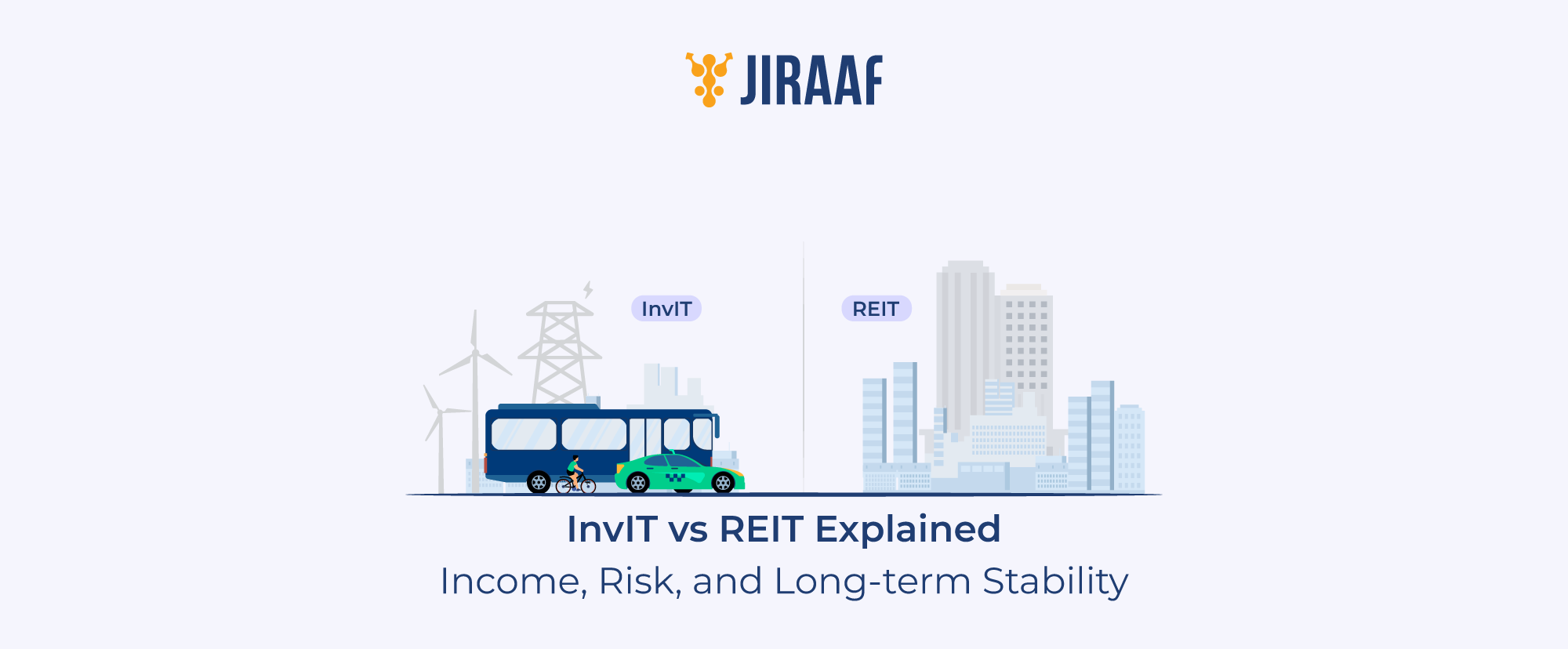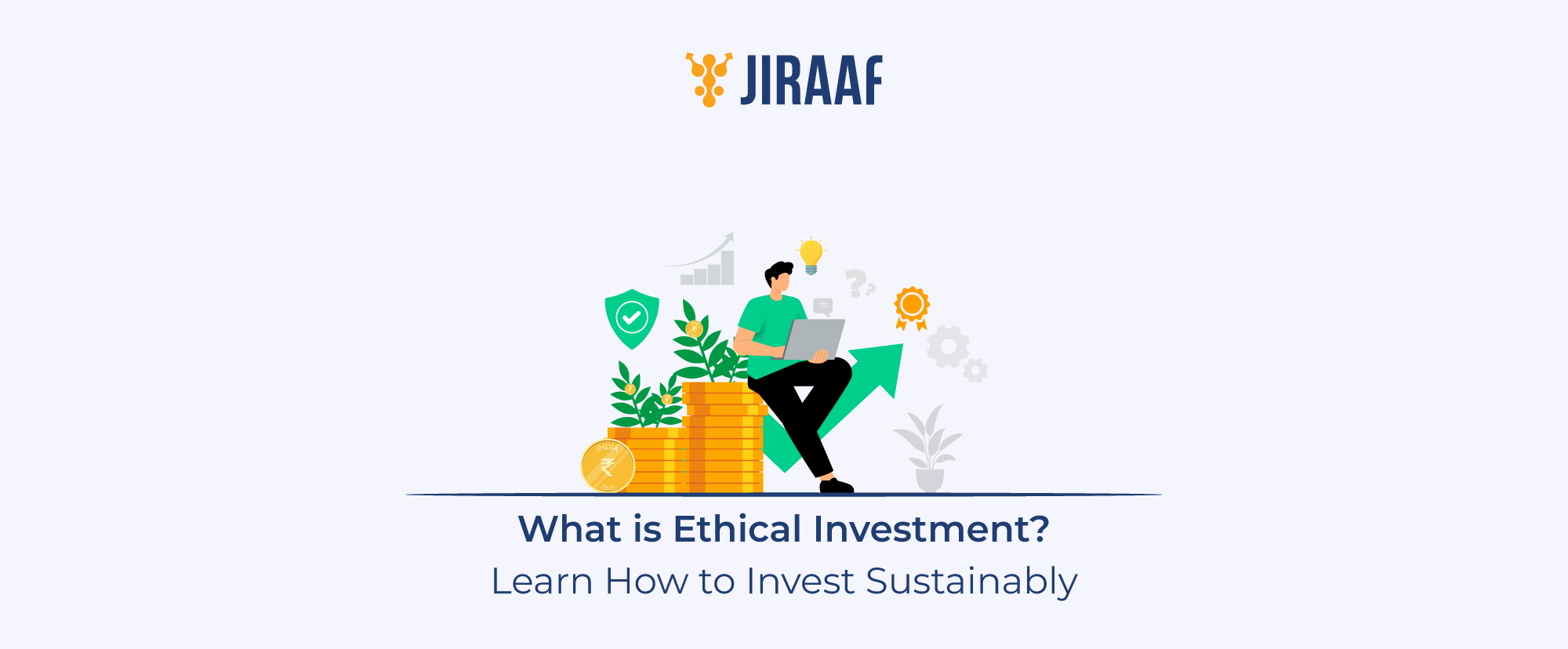Let’s face it, navigating the personal financial maze isn’t a cakewalk. While the stock market often dominates people’s investment decisions, the bond market quietly powers economies, offering savvy investors opportunities to balance portfolios and secure steady returns. But here’s the catch: most personal finance journeys don’t consider bonds until it’s too late.
90% of investments in bonds come from HNIs while only 10% come from retail investors. The reality is that bonds aren’t just for seasoned investors or large institutions. Bonds are a must-have in most portfolios, whether you’re planning for retirement, building a diversified portfolio, looking for steady returns in uncertain times or seeking tax efficiency, the bond market (global and Indian) presents solutions tailored to your financial goals. There’s a bond for every goal and every investor.
This blog will guide you through the nuances of the bond market and highlight how this often-underrated asset class can be a valuable addition to your personal finance strategy.
What is the Bond Market?
The bond market refers to a marketplace where debt securities, commonly known as bonds, are issued and traded. It serves as a crucial financial mechanism, allowing entities to borrow money from investors who, in return, earn interest over time.
Investors often see bonds as safer instruments compared to equities, making them an essential component of a diversified portfolio. Bonds are essentially a loan by an investor to a borrower, like a corporation or the government. In exchange, the issuer agrees to pay periodic interest (coupon rate) and return the principal at maturity. This predictable income stream is what makes bonds appealing to risk-averse investors.
In countries like the U.S., the bond market is dominated by government debt, particularly U.S. Treasury bonds. In India, the bond market is steadily evolving, with government securities (G-Secs) playing a dominant role. Recent initiatives like the inclusion of Indian bonds in global indices have bolstered foreign investor participation, further integrating India into the global bond ecosystem.
How Does the Bond Market Work in India?
The bond market in India operates through a well-defined structure regulated by governing institutions such as the Reserve Bank of India (RBI) and the Securities and Exchange Board of India (SEBI).
These bodies ensure market efficiency, transparency, and investor protection in the ever-evolving bond market through:
A) Regulatory Framework
- The RBI oversees the issuance of government securities (G-Secs), manages the monetary policy influencing interest rates, and ensures the smooth functioning of the primary market for government bonds
- SEBI regulates corporate bonds and ensures fair practices among market participants. It oversees disclosures, credit ratings, and trading practices to protect investors from fraud or misinformation
B) Market Participants
The Indian bond market includes:
- Governments and corporations that raise capital by offering bonds
- Institutional investors like banks, mutual funds, insurance companies, and foreign portfolio investors (FPIs) dominate trading activities
- Retail investors who now have easier access to government securities with schemes like RBI’s Retail Direct
- Market intermediaries like brokers, dealers, and credit rating agencies that facilitate market efficiency
C) Infrastructure and Trading Platforms
- Primary market where bonds are issued for the first time through auctions (for G-Secs) or private placements (for corporate bonds)
- Secondary market whereexisting bond trading occurs through over-the-counter (OTC) transactions or on stock exchanges. Platforms like the NSE and BSE ensure liquidity and transparency for secondary bond trading
- Clearing and settlement, where organizations like the Clearing Corporation of India Limited (CCIL) guarantee smooth settlement processes, reducing counterparty risks
D) Innovations and Accessibility
Recent developments in India’s bond market are bridging the gap between institutional and retail participation:
- RBI’s Retail Direct Scheme was introduced to empower individual investors. This initiative allows them to buy and hold government bonds directly without intermediaries
- ETFs focused on bonds provide a simplified way for investors to diversify across fixed-income instruments
This comprehensive oversight and vigilance from the regulatory bodies helps investors stay safe while they build their optimal portfolios.
Stability of Bond Prices
Bond prices are influenced by several factors, including interest rates, credit ratings, and market demand. When interest rates rise, bond prices typically fall, and vice versa. This inverse relationship between interest rates and bond prices is a critical concept for you as an investor to understand.
Other factors affecting bond stability include:
- Creditworthiness of Issuers: Bonds issued by entities with strong credit ratings tend to exhibit stable prices
- Economic Conditions: Macroeconomic indicators, such as inflation and GDP growth, can impact investor sentiment and bond valuations
Bond rates tend to exhibit overall stability due to factors such as fixed coupon payments, maturity dates, and their relative safety compared to other investment options.
Types of Bond Markets
Based on Buyers
- Primary bond market where entities raise fresh capital by issuing bonds directly to investors
- Secondary bond market where investors trade existing bonds, providing liquidity and price discovery
Based on the Type of Bond
1. Government Bond Market
Government bonds are debt instruments issued by the central or state governments. These include:
- Treasury bills (T-bills), which are short-term instruments with maturities of up to one year
- Dated securities that are long-term bonds with fixed or floating interest rates
- State development loans (SDLs) are issued by state governments to finance infrastructure and development projects
2. Corporate Bond Market
Corporate bonds are issued by companies to fund operations, expansion, or other financial needs. Unlike government bonds, these come with credit risk, making ratings by agencies like CRISIL crucial.
- Investment-grade bonds are issued by financially strong corporations with relatively lower risk
- High-yield bonds that offer higher returns but come with greater credit risk
History of the Bond Markets
The bond market is believed to have had ancient roots, dating back to Mesopotamian times when debt instruments were traded in rudimentary forms on stones. Followed the 1100s, when Venice started issuing government bonds. Modern bond markets took shape in the 17th century with the issuance of government debt in Europe.
In India, the bond market’s development gained momentum post-independence, with government securities dominating the landscape. Over time, corporate bonds and municipal bonds also gained traction, reflecting the growing complexity and maturity of the market.
In recent years, India’s bond market has expanded with initiatives from the RBI, like their Retail Direct Scheme, enabling individual investors to access government securities directly. This development has democratized bond investments and increased retail participation.
Trends in the Indian Bond Market: A Decade in Review
The Indian bond market has undergone significant transformation over the past decade, reflecting structural improvements and evolving investor preferences. It has grown by 77% in the last five years.
One of the major trends has been the steady rise of corporate bonds, driven by regulatory support and an increasing appetite for higher-yield investments among institutional and retail investors. Corporate bonds now constitute approximately 22% of the bond market, highlighting their growing importance in portfolio diversification and capital raising for businesses.
The last ten years have also seen a concerted effort toward deepening the market infrastructure. The Reserve Bank of India and the Securities and Exchange Board of India have introduced reforms to improve transparency and liquidity, such as electronic trading platforms and efforts to standardize bond issuances. This has made the market more accessible to retail participants, a shift from its traditional dominance by institutional investors.
Interest rate trends and inflationary pressures have also shaped the market significantly. For example, periods of declining interest rates during the mid-2010s encouraged higher bond issuances as companies took advantage of lower borrowing costs. In contrast, the post-pandemic years saw heightened volatility due to global monetary tightening, influencing yields and investor behavior.
Another key development is the increased integration of India’s bond market with global financial markets. Foreign portfolio investments in corporate bonds have grown, albeit with periodic fluctuations due to regulatory changes and currency risks. Collectively, these trends illustrate a maturing bond market that is increasingly becoming a cornerstone of India’s financial ecosystem.
Benefits of Investing in Bonds
Some prime benefits of investing in bonds are:
- Stability and Fixed Returns: Unlike equities, which can fluctuate widely in value, bonds provide steady income through fixed interest payments. This makes them an ideal option for individuals seeking financial consistency, especially retirees or those with a low-risk appetite.
- Lower Risk Compared to Equities: Compared to the inherent volatility of the stock market, bonds are relatively secure investment instruments. Government bonds come with sovereign guarantees. For risk-averse investors, this security serves as a safety net during uncertain economic conditions.
- Diversification Benefits: A well-diversified portfolio is crucial to managing financial risks effectively, and by adding bonds to your investment mix, you can mitigate the impact of market volatility on your overall portfolio. Bonds tend to offer a hedge against downturns in the stock market and help ensure that your investment strategy remains resilient.
- Liquidity: The secondary bond market enhances the liquidity of these instruments, allowing investors to trade bonds before they mature. This flexibility is particularly beneficial if you may need access to your funds sooner than expected or value financial freedom in your portfolio.
- Tax Benefits: Certain bonds, like tax-saving bonds or tax-free bonds, offer attractive tax incentives that can enhance your overall returns. By incorporating such tax-efficient instruments into your portfolio, you can maximize your earnings while staying compliant with tax regulations.
Risks and Challenges of the Bond Market
Despite their advantages, bonds are not without some risks, like:
- Inflation Risk: Rising inflation can erode real returns. If inflation exceeds the bond’s yield, the investor experiences a negative real return
- Market Volatility: Economic and geopolitical factors can impact bond prices. For instance, recent global events have led to fluctuating yields in emerging capital markets like India
- Regulatory Changes: Policy shifts, such as changes in tax treatment or investment caps for foreign investors, may alter the dynamics of the bond market in India
Should You Invest in the Indian Bond Market?
Investing in bonds can be tailored to different investor profiles, making them a versatile option for meeting specific financial goals.
Here’s a breakdown of who should consider and how they might benefit from bonds:
1. Conservative Investors Seeking Stability
For individuals prioritizing capital preservation and consistent income, government bonds or high-rated corporate bonds are ideal.
These options offer predictable interest payments and lower risk, especially for retirees or those nearing retirement who need steady income streams without exposing their principal to significant market fluctuations.
2. Moderate Risk-takers Looking for Diversification
Investors aiming to balance risk and returns within their portfolio can benefit from bonds as a stabilizing component. Corporate bonds, particularly those rated AA or higher, provide better yields than government bonds while maintaining a reasonable risk level.
This category suits mid-career professionals seeking diversification and moderate returns to complement equity investments.
3. Retail Investors Exploring Fixed Income
With growing accessibility in the bond market, retail investors like you can now participate more easily. Bonds traded on exchanges or through dedicated platforms allow small-scale investors to add fixed-income assets to their portfolios.
Tax-saving bonds, such as municipal or infrastructure bonds, can be particularly appealing for you if you’re seeking the dual benefits of income and tax efficiency.
These profiles illustrate the versatility of bonds as an investment tool, allowing individuals to align their bond choices with financial objectives, risk tolerance, and life stages.
How to Invest in the Bond Market?
To make the most of this investment avenue, you can:
i. Understand Your Investment Goals
Begin by assessing your financial objectives. Are you looking for steady income, capital preservation, or portfolio diversification? Your goals will determine the type of bonds that align with your needs, whether government bonds, corporate bonds, or tax-saving options.
ii. Research the Types of Bonds
Familiarize yourself with the different categories of bonds available in the market. Corporate bonds provide higher yields but come with varying levels of risk; government bonds offer safety with sovereign guarantees, and municipal or tax-free bonds offer tax advantages. Choose bonds that suit your financial profile and time horizon.
iii. Choose a Bond Market Platform
Bonds are available through multiple channels. You can invest in primary markets during initial offerings or purchase bonds from the secondary market through brokers or online platforms. Ensure that the platform you choose is regulated and reputable for a secure investing experience.
iv. Assess Yield and Maturity
Evaluate essential parameters like bond yield (the return you earn) and maturity periods. While long-term vs. short-term bonds can get you higher yields or quicker access to funds, respectively, you should align your selection with your liquidity needs and investment timeline.
v. Check Credit Ratings
Before investing in corporate or municipal bonds, review the issuer’s credit rating from agencies like CRISIL or ICRA. High-rated bonds are less likely to default, offering a safer option for cautious investors.
vi. Diversify Within Bonds
Just as diversification is crucial in equities, spreading your investments across different types of bonds can reduce concentration risk. For example, a mix of corporate, government, and international bonds can balance stability and returns.
vii. Monitor the Market and Reinvest
Review your bond investments periodically to ensure they align with your financial goals with time. Keep an eye on interest rate movements and market conditions that may affect bond prices. As bonds mature, consider reinvesting the proceeds to maintain your portfolio’s growth and income.
The Bottom Line
The bond market is more than just a conservative investment option; it is a dynamic space offering diverse opportunities for growth, stability, and income.
As the Indian bond market continues to mature, staying informed and proactive will help you make better investment decisions. Consulting with financial advisors or researching on your own through bond directories, etc. can provide better insight into bonds and further simplify your investment journey.
FAQs about the Bond Market
How is the Bond Market Different from the Stock Market?
While the stock market deals with equity investments, the bond market focuses on debt instruments, offering lower risk and fixed returns compared to the volatility of stocks.
Why Should Investors Consider Bonds for Their Portfolio?
Bonds provide stability, predictable income, and diversification, making them essential for balancing risk in a portfolio.
Can NRIs Invest in the Indian Bond Market?
Yes, NRIs can invest in Indian bonds, including government securities and corporate bonds, through designated accounts such as NRE or NRO accounts.
Discover fixed income investments with Jiraaf, a SEBI registered online bonds platform that educates and brings access to a wide array of bonds. Sign up today to explore diversified fixed income investment opportunities to support your goal-based wealth creation journey. Start investing!









